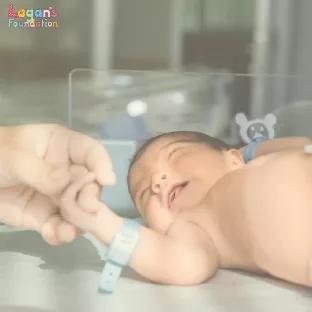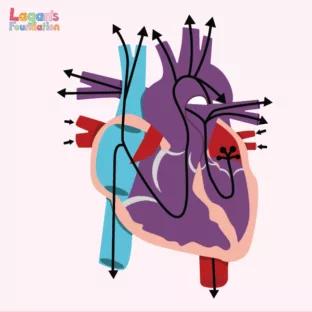
All you Need to Know About Surgery for Atrial Septal Defects (ASD)
Surgery for Atrial Septal Defects (ASD)
ASD surgery is a procedure to close an atrial septal defect, which is a hole in the heart between the two upper chambers.
Depending on the size of the hole, it may involve open-heart surgery or a minimally invasive procedure using a catheter to place the closure device.
It can be daunting for parents and guardians to process their child needing this surgery, but at Lagan’s Foundation, we can offer support every step of the way.
What Atrial Septal Defect treatments are available?
Treatment for Atrial Septal Defects (ASD) depends on the size of the hole, and whether the child has any other congenital heart defects. Many ASDs close on their own during childhood, but for those that don’t close, treatment may be required.
Medications can be used to help reduce signs and symptoms, but they will not repair an actual ASD. Medications may include beta blocker drugs to control the heartbeat, or anticoagulants to reduce the risk of blood clots.
Some small Atrial Septal Defects might not require such treatment and doctors may only recommend monitoring it with regular health checkups to see if it closes on its own.
If the hole is medium sized or larger, many cardiologists will recommend surgery to repair the hole and prevent complications further down the line.
What is the best age to have Atrial Septal Defect surgery?
The best age to have Atrial Septal Defect surgery is around 2-4 years old, since this is usually when signs and symptoms of an ASD will occur.
Babies and children with isolated Atrial Septal Defects are usually asymptomatic; however, early intervention may be necessary for babies who present rapidly enlarging defects.
How does Atrial Septal Defect closure surgery work?
For both adults and children, Atrial Septal Defect closure surgery involves closing the hole in the heart. This can be done two ways:
- Open-heart surgery – This type of Atrial Septal Defect repair surgery involves an incision through the chest wall to access the heart directly. Surgeons will use patches to close larger holes and sutures to close smaller defects.
- Catheter-based repair – A catheter, which is a thin, flexible tube, is inserted into a blood vessel, usually in the groin, and guided to the heart via imaging techniques. A mesh patch or plug is passed through the catheter and used to close the hole. Heart tissue will then begin to grow around the seal, permanently closing the hole.
If your child has surgery, they will receive general anesthesia and won’t feel any pain or be able to move around during the surgery.
How long does ASD repair surgery take?
Most Atrial Septal Defect repair surgeries will last around 3 hours, potentially less depending on the size and complexity of the hole.
Complications are rare and most patients will be able to leave the hospital 3 or 4 days after surgery.
What are the benefits of Atrial Septal Defect closure surgery?
Closing an Atrial Septal Defect will help to improve heart functions and reduce risks of complications associated with ASD, such as heart failures and stroke. Without treatment, ASD may allow excess blood to leak into the lungs, potentially causing lung damage.
Since catheter-based repair doesn’t require a large incision, this procedure can offer significant benefits. Patients typically recover quicker than those who have undergone open-heart surgery, and will usually also suffer from less pain after the surgery.
Are there risks involved in Atrial Septal Defect surgery?
Atrial Septal Defect closures are safe and the chances of complications associated with ASD closures are low. Complications are rare, but the risks can include:
- Bleeding
- Irregular heart rhythms, known as arrhythmia
- Kidney failure
- Infection around the closure
- Stroke or transient ischemic attacks (TIA)
What is the success rate of Atrial Septal Defect closure surgery?
Success rates of Atrial Septal Defect closure surgery are high, with most patients not having any issues at all after the surgery. Most children will have no difficulty with physical activity or restrictions after ASD repair.
Your child will need to have regular follow up appointments with a paediatric cardiologist to ensure issues do not occur as your child grows.
What is the recovery time after Atrial Septal Defect closure surgery?
The recovery time for Atrial Septal Defect closure surgery will depend on the type of surgery your child has had. A cardiologist will give you a rough estimate of how long your child will take to recover.
For catheter-based surgery, you should be able to resume your normal activities within one week. However, you will likely need to take medication for at least six months to prevent blood clots from forming after the procedure.
The recovery time for open heart surgery will usually take six to eight weeks and your child’s breastbone and chest muscles will gradually heal as they return to a normal daily routine.
At Lagan’s Foundation, we offer respite care to families with children with Complex Health Needs, specialising in Heart Defects and Feeding Issues.
All staff and volunteers receive specialist training and are observed and assessed throughout their time with the charity to ensure the highest level of care is delivered to all of the families receiving respite. ASD’s and VSD’s are covered in the cardiac awareness training to enable our team to offer full support.
Can an Atrial Septal Defect come back after closure?
Very rarely will people need to have repeat surgery to close a reopened hole or an opening which was left behind after Atrial Septal Defect surgery.
Holes reopening is very rare, and a repeat procedure is only necessary if the hole is large enough to cause problems.
What is the life expectancy for a child after Atrial Septal Defect closure surgery?
Usually, people who are 25 years old or younger who have had Atrial Septal Defect closure surgery have about the same life expectancy as other people the same age who have never had an ASD.
Those who have had Atrial Septal Defect closure surgery usually tend to live longer than those who have an ASD and haven’t had the procedure.


![Understanding Total Anomalous Pulmonary Venous Return [TAPVR]](/wp-content/uploads/2025/04/Understanding-Total-Anomalous-Pulmonary-Venous-Return-FI-312x312-c-default.jpg)


